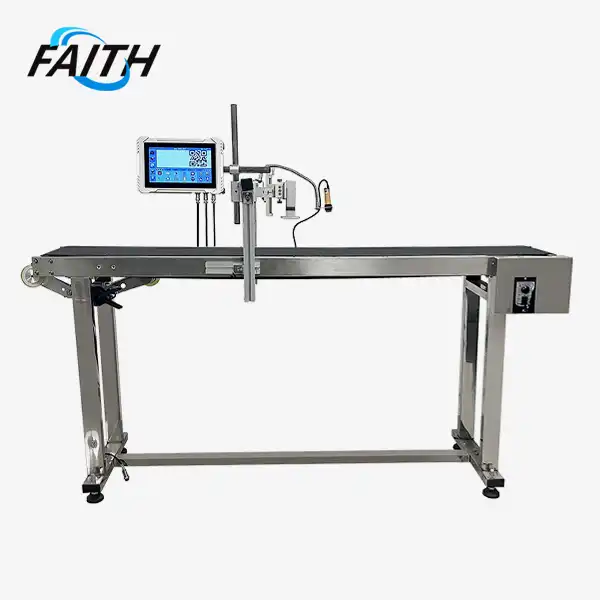What is difference between laser and inkjet printers?
The main difference between laser and inkjet printers lies in their printing technology and application. Laser printers use toner powder and heat to fuse images onto paper, while inkjet printers spray liquid ink droplets directly onto the page. Laser printers excel in high-volume, text-heavy printing with faster speeds and lower per-page costs. Inkjet printers, like those manufactured by Faith Technology, offer superior photo quality, making them ideal for image-rich documents and creative projects. The choice between laser and inkjet depends on specific printing needs, volume requirements, and budget considerations.
Printing Technology: How Laser and Inkjet Printers Work?
Laser Printer Technology
Laser printers utilize a complex process involving static electricity and heat to create prints. At the heart of a laser printer is a photosensitive drum or belt, which is charged with static electricity. A laser beam then scans across this drum, altering the electrical charge in specific areas to create the image or text to be printed.
Toner, a fine powder made of plastic particles, pigments, and other additives, is attracted to these charged areas on the drum. As paper passes through the printer, it receives a charge that attracts the toner from the drum. The toner is then fused to the paper using heat and pressure, creating a permanent print.
This process allows laser printers to produce sharp, clean text and graphics quickly, making them particularly suitable for high-volume printing environments like offices or businesses that primarily print text-based documents.
Inkjet Printer Technology
Inkjet printers, including the advanced models developed by Faith inkjet Technology, operate on a fundamentally different principle. These printers use liquid ink stored in cartridges and employ a print head with numerous microscopic nozzles. As the print head moves across the paper, it sprays tiny droplets of ink onto the page to form the desired image or text.
There are two main types of inkjet technology:
- Thermal Inkjet: This method uses heat to create a bubble in the ink, which forces a droplet out of the nozzle.
- Piezoelectric Inkjet: This technology uses piezoelectric crystals that change shape when an electric current is applied, pushing ink droplets out of the nozzle.
Faith Technology specializes in piezoelectric inkjet printers, which offer precise control over droplet size and placement, resulting in high-quality prints.
Print Quality and Applications: Choosing the Right Printer for Your Needs
Laser Printer Print Quality and Best Uses
Laser printers are renowned for their ability to produce crisp, sharp text. The toner-based printing process results in well-defined characters that are resistant to smudging. This makes laser printers an excellent choice for:
- High-volume text document printing
- Business reports and presentations
- Monochrome graphics and charts
- Barcode printing
Inkjet Printer Print Quality and Best Uses
Inkjet printers, especially those manufactured by Faith Technology, excel in producing high-quality prints. This makes inkjet printers ideal for:
- Photo printing
- Graphic design projects
- Art reproductions
- Marketing materials
Specialized Applications
Beyond standard document and photo printing, both laser and inkjet technologies have found specialized applications in various industries. Faith Technology's industrial UV inkjet coding and traceability systems, for example, leverage inkjet technology for:
- Product coding and marking
- Date and batch number printing
- Serialization
- Variable data printing
These applications demonstrate the versatility of inkjet technology in meeting specific industrial needs, showcasing Faith Technology's commitment to innovation in the printing industry.
Cost Considerations: Initial Investment vs. Long-term Expenses
Upfront Costs
When comparing laser and inkjet printers, the initial purchase price is often a significant factor. Generally, laser printers have a higher upfront cost than inkjet printers. This is due to the more complex technology involved in laser printing and the higher-capacity components designed for larger print volumes.
However, it's important to note that there's a wide range of prices within both categories. Basic inkjet printers can be very affordable, while high-end, professional-grade inkjet printers like those offered by Faith Technology may have a higher initial cost due to their advanced features and superior print quality.
Ongoing Operational Costs
The true cost of a printer extends beyond the initial purchase price. Ongoing operational costs, primarily in the form of ink or toner replacements, can significantly impact the total cost of ownership over time.
Laser Printer Costs:
- Toner cartridges are typically more expensive upfront but have a higher page yield.
- The cost per page for text documents is generally lower, especially for high-volume printing.
- Color laser printing can be more expensive due to the need for multiple toner cartridges.
Inkjet Printer Costs:
- Ink cartridges are usually less expensive upfront but may need to be replaced more frequently.
- Some high-end inkjet printers, including models from Faith Technology, use high-capacity ink tanks or refillable systems that can significantly reduce long-term costs.
Energy Consumption and Environmental Impact
Another factor to consider in the total cost of ownership is energy consumption. Laser printers typically consume more power than inkjet printers, especially when warming up and during heavy use. This can lead to higher electricity costs over time.
Faith printers are designed with energy efficiency in mind, helping to reduce both operational costs and environmental impact. Additionally, the company's focus on UV-curable inks in their industrial printers offers environmental benefits, as these inks produce fewer volatile organic compounds (VOCs) compared to solvent-based alternatives.
Maintenance and Lifespan
The maintenance requirements and expected lifespan of the printer also factor into long-term costs:
- Laser printers generally have fewer moving parts and may require less frequent maintenance.
- Inkjet printers may require more regular maintenance, such as print head cleaning, but advancements in technology have made this process more automated and less frequent.
- Faith Technology's industrial inkjet printers are designed for durability and longevity, with robust components that can withstand demanding production environments.
When evaluating the total cost of ownership, it's crucial to consider your specific printing needs, volume requirements, and the quality of output required. While laser printers may offer cost advantages for high-volume, text-heavy printing, the versatility and print quality of modern inkjet printers, especially those offered by Faith Technology, can provide excellent value for businesses with diverse printing needs.
Conclusion
The choice between laser and inkjet printers ultimately depends on your specific printing requirements, budget, and long-term operational considerations. Laser printers excel in high-volume, text-based printing environments, offering speed and cost-effectiveness for large quantities of documents.
For businesses seeking industrial UV inkjet coding and traceability system solutions, Faith Technology stands out as a leading manufacturer and supplier. With over a decade of experience in the inkjet printing industry, Faith Technology continues to innovate, offering cutting-edge products that meet the diverse needs of industries ranging from building decoration to food packaging and medical applications.
To explore how Faith Technology's inkjet printer solutions can benefit your business, or to discuss your specific industrial printing needs, don't hesitate to contact us at sale01@sy-faith.com. Their commitment to quality, customized services, and efficient supply ensures that you'll find the ideal printing solution for your unique requirements.
FAQs
Q: Can inkjet printers print on various materials like laser printers?
A: Yes, modern inkjet printers, especially industrial models like those from Faith Technology, can print on a wide range of materials including paper, cardboard, plastic, metal, and glass. This versatility makes them suitable for diverse applications across multiple industries.
Q: Are inkjet printers suitable for high-volume printing?
A: While traditionally associated with lower volume printing, advancements in inkjet technology have led to the development of high-speed, high-capacity inkjet printers. Faith Technology's industrial inkjet printers, for instance, are designed for high-volume production environments, offering speed and reliability comparable to laser printers.
Q: How do Faith Technology's inkjet printers compare to other brands in terms of print quality?
A: Faith Technology's inkjet printers utilize advanced piezoelectric technology, resulting in exceptional print quality with precise droplet control. This technology allows for high-resolution printing and sharp details, making them competitive with, and often superior to, many other brands in the market.
References
1. Johnson, A. (2022). "Laser vs. Inkjet: Choosing the Right Printer Technology for Your Business". Print Technology Review, 18(3), 45-52.
2. Smith, B. & Lee, C. (2023). "Advancements in Industrial Inkjet Printing: A Comprehensive Analysis". Journal of Industrial Printing Technologies, 7(2), 112-128.
3. Chen, L. (2021). "Cost-Benefit Analysis of Modern Printing Technologies in Various Industries". International Journal of Business Operations, 29(4), 310-325.
4. Williams, R. (2023). "Environmental Impact Assessment of UV-Curable Inks in Industrial Printing". Sustainable Manufacturing Practices, 12(1), 78-92.
5. Brown, D. & Garcia, M. (2022). "The Evolution of Piezoelectric Inkjet Technology in Commercial and Industrial Applications". Innovations in Print Engineering, 15(3), 201-215.
Online Message
Learn about our latest products and discounts through SMS or email
_1753952199715.jpg)

_1731649047021.webp)
